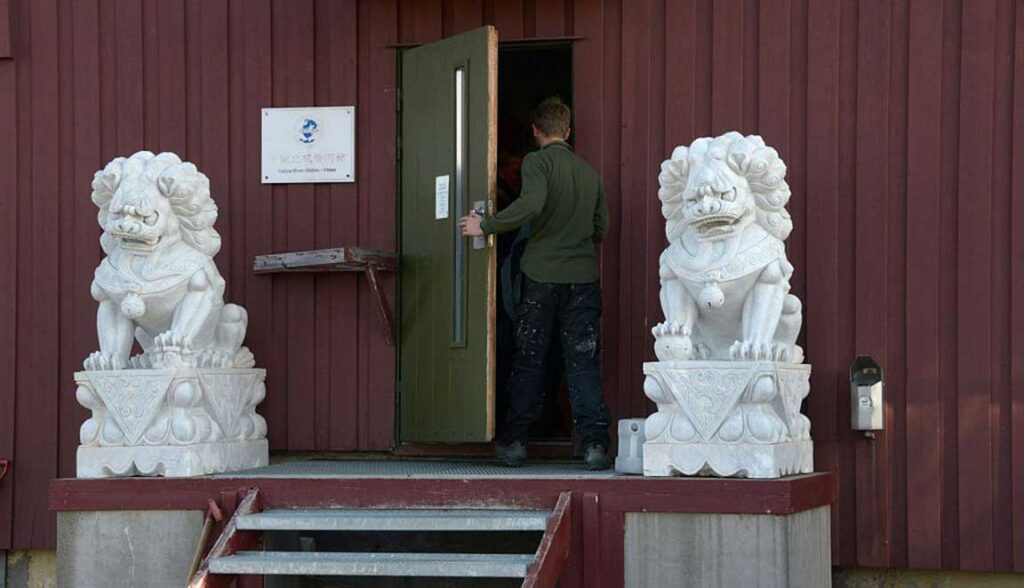Chinese-style lions guard the entrance to the People’s Republic of China’s scientific station in Norway’s Svalbard archipelago. The PRC’s increased activity in dual-use research, which can also have military applications, concerns many Arctic experts. AFP/GETTY IMAGES
THE WATCH STAFF
An investigation by Newsweek, a United States news magazine, found that the People’s Republic of China is pursuing “dual-use” scientific research in the Svalbard archipelago in Norway’s High North — as well as the Chukchi Sea near the Bering Strait — that could also be used to advance its military interests and Arctic ambitions. The PRC is also increasing its presence in Iceland. The actions of the self-declared “near-Arctic nation” have raised concerns among Arctic experts that the PRC is planning to subvert the traditional demilitarized status of the Arctic as climate change creates more opportunity for trade and resource extraction.
The highest number of PRC researchers since the COVID-19 epidemic began are working in Svalbard this summer, the magazine reported. Newsweek found that a PRC scientific institute, part of the country’s defense establishment, is operating on the island, which was demilitarized by a 1920 treaty. Additionally, the PRC is using a satellite ground station on Svalbard to aid a Chinese aerospace defense contractor despite a ban on data transmission “only or mainly” for military purposes. “China is where I think most of the Arctic tension is becoming really problematic, because we just haven’t worked with them in the Arctic before,” Gregory Falco, a professor of aerospace engineering at Cornell University, told Newsweek. “It’s a new player that we really didn’t expect to have there.”
The PRC says its goals for the Arctic are to “safeguard the common interests of all countries and the international community,” according to a statement provided to Newsweek from the PRC’s embassy in Oslo. But the Arctic is already the sovereign territory of eight nations. China’s nearest point to the region is nearly 1,450 kilometers away.
Newsweek’s investigation found that China Research Institute of Radio Wave Propagation (CRIRP), which has two active projects on Svalbard, belongs to China Electronics and Technology Group Corp., known as CETC, the PRC’s biggest military electronics conglomerate. CRIRP conducts atmospheric and ionospheric observation in Svalbard. It studies space weather, the northern lights and electrons, which are important for target detection, tracking and identification. “My assessment is that this institute does it all, from climate to bore hole drilling for oil and gas to classified radar research,” said LJ Eads, the founder of Data Abyss, which is co-funded by the Pentagon. “There is still clear environmental and atmospheric research that isn’t advancing the PLA,” Eads said, referring to China’s People’s Liberation Army. “The problem is that it’s also dual use.”
Defense contractor Shenzhen Aerospace Dongfanghong uses a satellite ground station on Svalbard. And Svalbard is not the only place in the Arctic where Chinese scientists are active. In the Chukchi Sea by the Bering Strait, where the U.S. and Russia meet, scientists from the military-linked Harbin Engineering University are researching underwater acoustics, which is crucial for submarine navigation. In Iceland, the PRC is researching the upper atmosphere and space including with LiDAR technology, which measures distances to targets with lasers. This type of dual-use research by the PRC is the main concern in the Arctic, Marc Lanteigne, a professor of political science at The Arctic University of Norway in Tromsø, said. “Chinese scientific interests and projects in the Arctic are likely to be used for strategic and military progress. It’s understood that this information will be transmitted to the Chinese military. That’s simply the nature of the Chinese government.”

